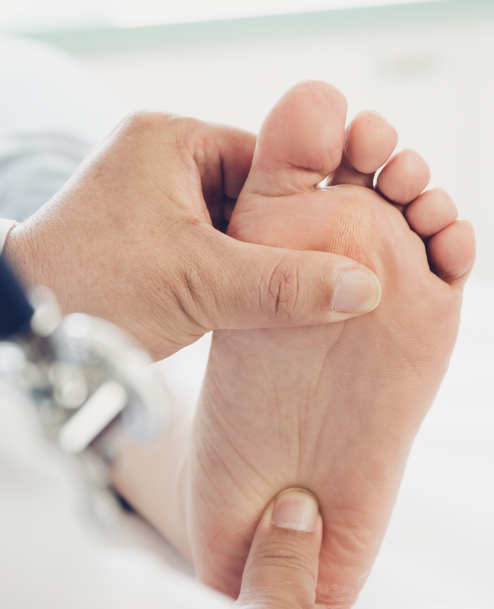Foot Related Conditions
Hammer or Claw Toes
Hammertoe is the general term used to describe an abnormal contraction or “buckling” of the toe because of partial or complete dislocation of one of the toe joints.
As the toe becomes deformed, it rubs against the shoe, and the irritation causes the body to build up thicker skin to help protect the area. The common name for the thicker skin is a corn. At first, this thick skin helps reduce irritation to the bone prominence, but as the skin becomes thicker, it adds to the pressure from the shoe. Periodic trimming of the corn may give temporary relief. However, a bursa may develop over time, and if it becomes inflamed (bursitis), the area becomes red, swollen and painful and may also become infected.
Do not confuse corns with calluses that occur on the bottom of the feet. They are generally caused by other conditions, although a severe hammertoe may create downward pressure on a metatarsal bone at the ball of the foot and add to the cause of a callus.
ham•mer•toe
A deformed claw-shaped toe and especially the second that results from permanent angular flexion between one or both phalangeal joints, also called claw toe.
How did this happen?
- Shoe choice
- Hereditary
- Low or flat arches
- High arches
What can I do about it?
- Choose well-fitted, comfortable, low-heeled shoes that don’t irritate the toe
- High heel shoes should be worn at a minimum
- Don’t wear tight socks

How does a Chiropodist treat it?
Your chiropodist will examine your feet to determine the cause of the hammertoe and rule out other medical conditions. Treatments include:
- More appropriate footwear
- Periodic trimming and padding of the associated corn. Antibiotics may be used in the presence of infection.
- Removable silicone toe pads may be made for you to alleviate pressure.
- A custom-made orthotic may also be created for you to help minimize the effects of a flat or a high arched foot.
- If conservative treatment is unsuccessful, surgical intervention may be suggested.
Articles of Interest
Claw, Hammer & Mallet Toes
Curling your toes is a great way to get .....
Keep Your Feet on the Ground…and Keep Them Healthy!
Feet are designed to carry us to the places we .....
Help your Feet Perform at Peak Efficiency with Custom-made Orthotics…
Athletes of All Ages Can Benefit from Custom-Made Orthotics! No .....

